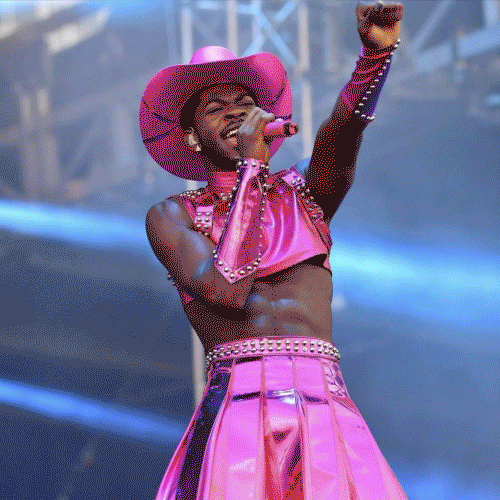YESTERQUEERS: MARIE ANTOINETTE, LESBIAN ICON
Welcome to WUSSY’s new monthly column, YESTERQUEERS. Each month, Kayla Goggin chooses a different person from the annals of history to examine as an LGBTQ icon.
Everyone knows Marie Antoinette: the infamous French monarch who met her end at the guillotine in 1793. Her status as a coded figure for female homoeroticism and as a proto-lesbian heroine is, to put it lightly, lesser known. This is the story of how Marie Antoinette became one of history's biggest lesbian icons.
An Austrian by birth, Marie Antoinette was married to Louis XVI, then the prince of France, when she was fourteen as part of a political alliance between their respective empires. The marriage agreement required Antoinette to renounce all of her Austrian titles and ties, leaving her isolated and alone in the cutthroat world of Versailles.
When Marie Antoinette eventually became queen at the age of nineteen in 1775, her reputation was already contentious. While the country was in the midst of a serious financial crisis, she spent obscene amounts of money on dresses and gambling (on her twenty-first birthday she gambled for seventy-two hours straight), and dropped a ridiculous amount of cash to renovate her private chateau, the Petit Trianon, to look like an Austrian hamlet. Meanwhile, her subjects were literally rioting in the streets for bread. Not great PR. (To be fair, she actually had very limited political influence with her husband.)
Speaking of Louis XVI, their relationship was. . . What's the word? Oh, right—depressing as fuck. By all accounts, Louis XVI was a nice guy but he was also weirdly obsessed with locks, famously indecisive, painfully shy, and constantly suspicious of his wife. It took them seven years to consummate their marriage, a fact that was public knowledge and made all the more humiliating by the fact that court decorum required their sheets be inspected each day for signs of blood and kingly "emissions." The couple's inability to produce an heir became another symbol of Antoinette's inadequacy.
The French reacted with subtlety. Just kidding. Pornographic cartoons, pamphlets, engravings, songs, and plays all lampooned Marie Antoinette as a heinous bitch, accusing her of adultery, incest, pedophilia, and, of course, lesbianism. The two most common pamphlets were called "The Royal Dildo" and "The Royal Orgy." In them, Antoinette is pictured using dildos on herself and other female companions, eating women out, and somehow having sex with her own father while still inside her mother's womb. It was the accusations of lesbianism that really lingered, though—perhaps because there may have been some truth to them.
In the midst of all of the graphic, extremely public hatred being thrown at her, Marie Antoinette retreated further into the relative safety of the court and sought intimacy from those closest to her: her ladies-in-waiting. Her favorite was the Princesse de Lamballe, a young widow with whom the queen became so infatuated that she gave her the cushiest job at court (superintendent of the household) and a lavish stipend. In their letters they addressed each other as "my dear heart" and signed "with a heart entirely yours."
During Marie Antoinette's first separation from the Princesse de Lamballe, she was apparently so depressed that she had the princess's portrait painted on the mirror of the room she used most. After a failed escape from the increasingly violent revolutionaries in Paris, the queen sent the princess a ring, set with a lock of her white hair and engraved with the phrase "bleached by sorrow." Lamballe sent back a watch "to remind [you] of the hours we passed together," saying she wished to "live or die" near the queen. When Antoinette was finally arrested by the revolutionaries, one of the last possessions taken from her was a miniature of the princess.
Eventually the Princesse de Lamballe got her wish—she was imprisoned soon after the queen and brutally murdered by a mob. Her head was then placed on a spike, paraded through the streets, and left outside the window of Marie Antoinette's cell. The mob screamed for the queen to give the princess one last kiss.
Even biographers who remain skeptical of Marie Antoinette's queerness acknowledge the intense intimacy of her relationship with the Princesse de Lamballe. The queen's interest in women extended beyond just the princess—she also seemed to have had a lengthy romantic affair with a woman named Yolande Polignac. Not only did Antoinette pay off all of Polignac's debts, she also made her a duchess and moved her into a thirteen-room apartment in Versailles. There's also Mary Robinson, a well-known English writer and actress at the time, who visited the queen at Versailles and wrote at length about their flirtation. Antoinette, according to Robinson, "appeared to survey, with peculiar attention, a miniature of the Prince of Wales, which [I] wore on my bosom." Yes, she was writing in 1783 about the queen of France checking out her cleavage.
It wasn't terribly unusual for women at court to have romantic relationships with one another, but that was mostly because people thought lesbian sex hadn’t been invented yet. If you were a woman who fingered another woman that didn't make you a lesbian, it just made you a sinner. In 1811, two schoolteachers won a lawsuit against a pupil's relative who accused them of lesbianism because the judges believed sex between women was literally impossible. Lesbian sex wasn't real sex. Women who loved other women were simply “engaged in a passionate friendship." Like everything involving genuine feminine pleasure, it was regarded as an innocent frivolity.
That meant all those really, really close friends didn't have many cultural reference points for their relationships. All the gay role models belonged to men. The classics are riddled with gay romance: Achilles and Patroclus in the Illiad, the Theban band of warrior-lovers in Plutarch, and Nisus and Euryalus in Virgil’s Aeneid. Then you had Alexander the Great, Michelangelo, Frederick II, Oscar Wilde, and Walt Whitman. Women had Sappho and Marie Antoinette.
Lesbians in the eighteenth and nineteenth centuries began to use the image of Marie Antoinette as a coded invocation—drop her name or mimic her style and you could secretly (and safely) reveal yourself to someone in the know. Famed nineteenth-century dyke and diarist Anne Lister once began a relationship with her long-time mistress by simply asking if the woman had heard the "rumors about Marie Antoinette."
There's a rich literary tradition of invoking the queen's name to symbolize lesbian desire. In Rose Laure Allatini's Despised and Rejected, the closeted lesbian heroine is named Antoinette. In Radclyffe Hall's The Well of Loneliness, the closeted lesbian heroine visits Versailles and laments the queen's tragic relationship with the Princesse de Lamballe. In Virginia Woolf's Orlando, memories of Marie Antoinette and the princess haunt the courtship scenes of Orlando and Sasha. In Djuna Barnes' Nightwood, the closeted lesbian heroine dresses up as the queen to hide from her husband. You get the picture. It's a tradition that carries on today—Madonna even dressed as Marie Antoinette in the video for "Vogue."
Although biographers as early as 1814 were split about the nature of her sexuality, even those who thought she was straight romanticized Marie Antoinette's relationships with women constantly. The breathless titillation that has always surrounded the queen's affairs has only served to infuse them with an enduring erotic charge. Whether she was or wasn't gay is almost beside the point—Marie Antoinette may have helped facilitate over 200 years of lesbian hookups, making her (probably) the first modern lesbian icon.
But let's be real: if the queen never commanded her subjects to eat cake, it was only because she was too busy eating pussy.
Kayla Goggin is a freelance writer based in Savannah, GA. She is the editor of the Savannah Art Informer, the arts columnist for Connect Savannah and has contributed writing to MESH Magazine, XOJane, and elsewhere.
Sources:
Strangers: Homosexual Love in the Nineteenth Century by Graham Robb.
“Anne Lister’s Construction of Lesbian Identity” by Anna Clark.
The Apparitional Lesbian by Terry Castle.
Encyclopedia of Lesbian Histories and Cultures, edited by Bonnie Zimmerman.
Fatal Women of Romanticism by Adriana Craciun.
Archive
- February 2025
- November 2024
- October 2024
- September 2024
- August 2024
- July 2024
- June 2024
- May 2024
- April 2024
- October 2023
- July 2023
- June 2023
- May 2023
- April 2023
- March 2023
- February 2023
- June 2022
- April 2022
- March 2022
- January 2022
- December 2021
- October 2021
- September 2021
- August 2021
- July 2021
- June 2021
- May 2021
- April 2021
- March 2021
- February 2021
- January 2021
- December 2020
- October 2020
- September 2020
- August 2020
- July 2020
- June 2020
- May 2020
- April 2020
- March 2020
- February 2020
- January 2020
- December 2019
- November 2019
- October 2019
- September 2019
- August 2019
- July 2019
- June 2019
- May 2019
- April 2019
- March 2019
- February 2019
- January 2019
- December 2018
- November 2018
- October 2018
- September 2018
- August 2018
- July 2018
- June 2018
- May 2018
- April 2018
- March 2018
- February 2018
- January 2018
- December 2017
- November 2017
- October 2017
- September 2017
- August 2017
- July 2017
- June 2017
- May 2017
- April 2017
- March 2017
- February 2017
- January 2017
- December 2015
- November 2015
- October 2015
- September 2015
- August 2015
- July 2015
- June 2015
- May 2015
- April 2015









